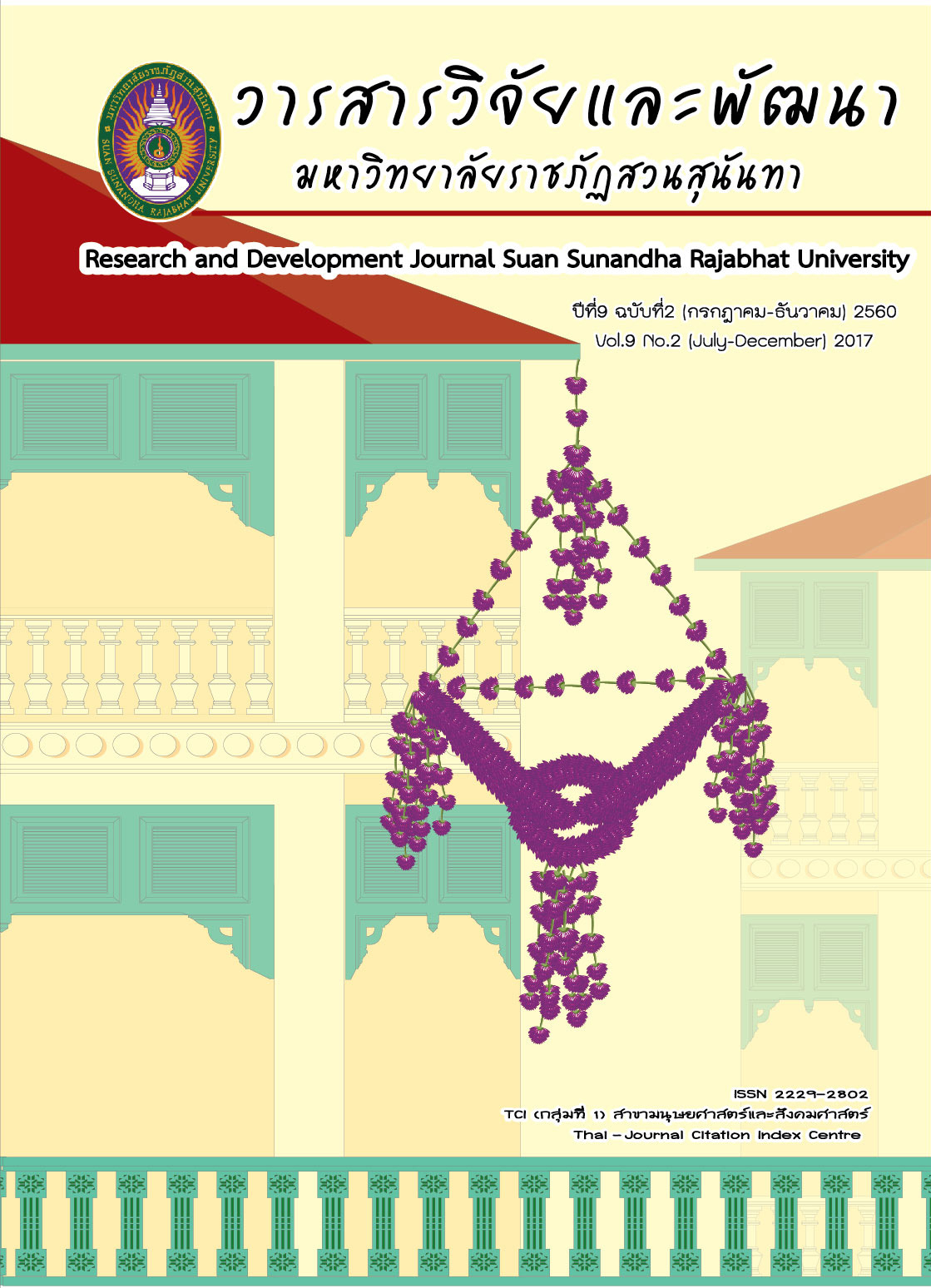อิทธิพลของภาวะผู้นำของผู้บริหารโรงเรียนและตัวแปรส่งผ่านที่มีผลต่อคุณภาพการเรียนรู้ของนักเรียนระดับชั้นประถมศึกษา สังกัดกรุงเทพมหานคร
DOI:
https://doi.org/10.53848/irdssru.v9i2.214164คำสำคัญ:
ภาวะผู้นำ ผู้บริหารโรงเรียน กรุงเทพมหานครบทคัดย่อ
การวิจัยครั้งนี้ มีวัตถุประสงค์ เพื่อสร้างโมเดลสมการโครงสร้างของภาวะผู้นำที่ส่งผลต่อคุณภาพการเรียนรู้ของนักเรียนระดับประถมศึกษา สังกัดกรุงเทพมหานคร และเพื่อตรวจสอบความตรงของโมเดลสมการโครงสร้างของภาวะผู้นำที่ส่งผลต่อคุณภาพการเรียนรู้ของนักเรียนระดับประถมศึกษา สังกัดกรุงเทพมหานคร เป็นการวิจัยเชิงปริมาณ ประชากรจากโรงเรียนประถมศึกษา จำนวน 432 โรงเรียน ประกอบด้วยกลุ่มบุคคล จำนวน 4 กลุ่ม ได้แก่ ผู้อำนวยการโรงเรียน จำนวน 432 คน ครูผู้สอน จำนวน 14,740 คน นักเรียน จำนวน 216,770 คน และคณะกรรมการเครือข่ายผู้ปกครอง จำนวน 3,456 คน รวมประชากรทั้งสิ้น จำนวน 235,398 คน โดยเปิดตารางเครซี่และมอร์แกน จากประชากร 432 โรงเรียน ได้กลุ่มตัวอย่าง จำนวน 205 โรงเรียน ในแต่ละโรงเรียนมีผู้ตอบแบบสอบถาม 3 กลุ่ม ได้แก่ ผู้บริหาร จำนวน 1 คน ครูผู้สอน จำนวน 5 คน และคณะกรรมการเครือข่ายผู้ปกครอง จำนวน 4 คน รวมทั้งหมด 10 คน เครื่องมือที่ใช้เป็นแบบสอบถามจำนวน 3 ฉบับ และแบบบันทึกผลการเรียนของนักเรียน จำนวน 3 รายการ โดยฉบับที่ 1 สอบถามผู้บริหาร ฉบับที่ 2 สอบถามครูผู้สอน และฉบับที่ 3 สอบถามคณะกรรมการเครือข่ายผู้ปกครอง สถิติที่ใช้ร้อยละ ค่าเฉลี่ย ส่วนเบี่ยงเบนมาตรฐาน โดยการวิเคราะห์ Path Analysis ด้วยโปรแกรมลิสเรล สรุปผลการวิจัยได้ดังนี้
1. โมเดลภาวะผู้นำของผู้บริหารโรงเรียน มีอิทธิพลทั้งทางตรงและทางอ้อมเชิงบวก รวมทั้งอิทธิพลรวมต่อชุมชนทางวิชาชีพของครู บรรยากาศในการเรียนรู้ ความผูกพันของผู้ปกครองและชุมชน ความไว้วางใจในโรงเรียน และการจัดการเรียนการสอนในห้องเรียน ซึ่งส่งผลต่อคุณภาพการเรียนรู้ของนักเรียน
2. ผลการตรวจสอบความตรงของโมเดล มีความตรงและสอดคล้องกลมกลืนกับข้อมูลเชิงประจักษ์อยู่ในเกณฑ์ดี โดยมีค่าไค-สแควร์ (chi-square) เท่ากับ 425.75 ค่าความน่าจะเป็น (P) เท่ากับ 1.00 ที่องศาอิสระ(df) เท่ากับ 652 ค่าไค - สแควร์สัมพัทธ์ (chi-square/df) เท่ากับ 0.65 ค่าดัชนีวัดระดับความสอดคล้อง (GFI) เท่ากับ 0.90 ค่าดัชนีวัดระดับความสอดคล้องที่ปรับแก้แล้ว (AGFI) เท่ากับ 0.89 ค่าดัชนีรากค่าเฉลี่ยกำลังสองของส่วนเหลือมาตรฐาน (standardized RMR) เท่ากับ 0.0043 และค่ารากของค่าเฉลี่ยกำลังสองของความคลาดเคลื่อน (RMSEA) เท่ากับ 0.000
เอกสารอ้างอิง
Schools : Partners for the quality
of the students.Bangkok Sangdow,
Publishing Limited.
Epstein,J.L. (1995). “School/family/
community partnerships: Caring
for the children we Share” Phi
Delta Kappan May: 701 – 702.
Freiberg, H. J. (1998).“ Measuring school
Climate : Let me count the
ways”. Educational Leadership.
56(1): 22-26. cited in Marshall, M.
L.2004. xamining School Climate:
Defining Factors and Educational
Influences University Center for
School Safety.
Hattie,J. (2011). Visible Learning: A
Synthesis of Over 800 MetaAnalyses Relating to Achievement.
Routledge: N.Y. Organization for
Economic Cooperation and
Development (OECD). (2010). PISA
2009. Results: What Makes a
School Successful? OECD Publishing.
Ho, Sui-Chu. (2007).“ Building trust in
elementary schools: the impact
of home school community
collaboration”. International Journal
about Parent in Education. 1, 8-20.
Hoy, W.K., C. J. and L. Witkoskie. (1992).
Open School/Healthy Schools:
Measuring Organizational Climate,
Sage, Beverly Hills, CA.
James Sebastian and Elaine Allensworth.
(2012). The Influence of Principal
Leadership on Student Learning
Quality: A study of Mediated
Pathways to Learning .Education
Administration Quarterly. The
University Council for Education
Administration. USA.
Khemmani, T. (2007). Science teaching:
the knowledge to manage the
learning process effective. (The
print 5) Bangkok, Office of the print
parade Chulalongkorn University.
Kittisaknawin, Ch. (2009). Trust in the
organization of the country. A
comparative study of public
sector organizations and private
sector enterprises. Thesis Ph.D.
Department of Public Administration,
Ramkumhang University.
Ministry of Education. (2008). The
measurement and evaluation
based on the core curriculum of
the Basic Education Curriculum
2008. Bangkok: Ladprao publishing.
Ministry of Education.( 2011). Core
Curriculum Education Basic
Edition 2008. Bangkok: ETO (ETO).
Molee, P. (2009). The analysis of the
causal relationship of the factors
that affect the leadership. School
administrators successful. Education
Doctoral Thesis Faculty of
Management Studies, Chulalongkorn
University.
Office of the Basic Education. (2010).The
guidelines focus on improving
the learner into practice. Bangkok.
Office of the Education Council, (2008).
The crisis of Thailand. Bangkok:
Partnership, V.T.C. Communications
applications
Office of the Education Council. (1999).
National Education 1999, improved
(Vol.2) 2002. Prik Hwan Graphics
company Limited.
Office of the Education Council. (2008).
The research of evaluated the
development of quality early
childhood (3 –5years). Bangkok:
Plearn studio.
Office of the National Education
Commission.(2011). Education Act
of 1999, improved (No. 2). BE
2002. Bangkok: Thaiwatana Panich.
Phopetch, A. (2012). Development
Indicators behavioral leadership
of the school administrators.
Basis. The thesis Ph.D. Faculty of
Management Studies, Siam University.
Plerin, G. (2009). Development Indicators
leadership for the management
of basic education. Education
Doctoral Thesis. Faculty of Management
Studies, Khonkan University.
Sebring, P. B., Allensworth, E., Luppescu,
S., & Easton, J. Q. (2010). Organizing
schools for improvement lessons
from Chicago. Chicago, IL:
University of Chicago Press.
Sopovitz, J., Sirinides, P., and May, H.
(2010). How Principals and Peers
Influence. Teaching and learning.
Educational Administration Quaterly,
46(1).
Sopovitz, J., Sirinides, P., and May, H..
(2006). “School Climate: The
Interplay Between Interpersonal
Relationships and Student
Achievement”. Journal of School
Leadership. 16(7): 11-14.
Srisaard, B. (2010). Initial research. (2nd
Edition).Bangkok: Suweeriyasart limit.
The National Institute of Educational
Testing Service (NIETS) (2011).
Guide to the study of basic
national Level2 (PS.6) and Level3
(m3). Year 2011, Bangkok.
The National Institute of Educational
Testing Service (NIETS) (2011).
Research report titled factors
causing the O-NET test scores of
students. Grade 6 and Grade 6
low. The National Institute of
Educational TestingService, Bangkok.
The Office of National Education
Standards and Quality Assessment .
(2007). The evaluation report
Outside the three levels of basic
education (2554-2558 BC).
Bangkok: Amarin Printing Ann.
Publishing Co., Ltd. (Thailand).
Tschannen-Moran, M. (1998). Trust in
schools: a conceptual and
empirical analysis”. Journal of
Educational Administration. 36(4),
334-352.
Wiruchchai, N. (1999). Model LISREL
statistical analysis for research.
Edition 3. Bangkok's Chulalongkorn
plublishing
ดาวน์โหลด
เผยแพร่แล้ว
รูปแบบการอ้างอิง
ฉบับ
ประเภทบทความ
สัญญาอนุญาต
บทความที่ได้รับการตีพิมพ์เป็นลิขสิทธิ์ของ สถาบันวิจัยและพัฒนา มหาวิทยาลัยราชภัฎสวนสุนันทา
ข้อความที่ปรากฏในบทความแต่ละเรื่องในวารสารวิชาการเล่มนี้เป็นความคิดเห็นส่วนตัวของผู้เขียนแต่ละท่านไม่เกี่ยวข้องกับมหาวิทยาลัยราชภัฎสวนสุนันทา และคณาจารย์ท่านอื่นๆในมหาวิทยาลัยฯ แต่อย่างใด ความรับผิดชอบองค์ประกอบทั้งหมดของบทความแต่ละเรื่องเป็นของผู้เขียนแต่ละท่าน หากมีความผิดพลาดใดๆ ผู้เขียนแต่ละท่านจะรับผิดชอบบทความของตนเองแต่ผู้เดียว





